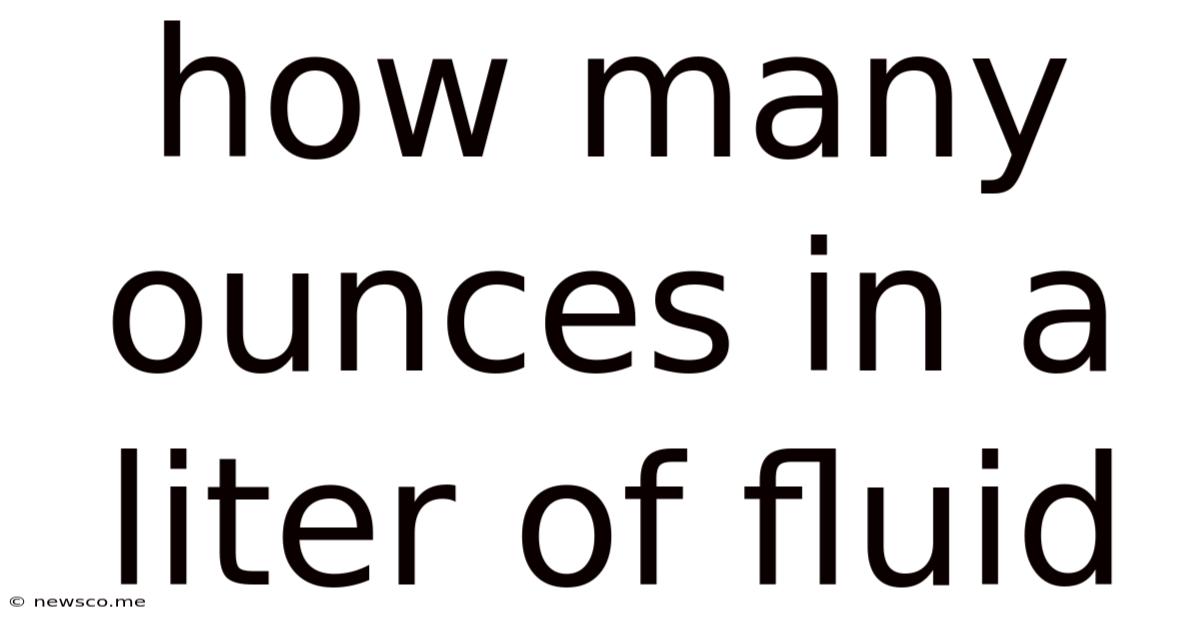How Many Ounces In A Liter Of Fluid
News Co
Apr 23, 2025 · 4 min read

Table of Contents
How Many Ounces in a Liter of Fluid? A Comprehensive Guide
Knowing how to convert between different units of measurement is a crucial skill, especially when dealing with liquids. Whether you're cooking, baking, following a scientific experiment, or simply trying to understand the specifications on a product label, understanding the relationship between ounces and liters is invaluable. This comprehensive guide will delve deep into the conversion, exploring the nuances and providing you with practical applications to solidify your understanding.
Understanding the Units: Ounces and Liters
Before we jump into the conversion, let's briefly define the units we'll be working with:
Ounces (oz)
The ounce is a unit of volume commonly used in the United States and some other countries. It's important to note that there are fluid ounces (fl oz) and avoirdupois ounces, which measure weight. When dealing with liquids, we always use fluid ounces. A fluid ounce is a unit of volume, referring to the amount of liquid the container can hold.
Liters (L)
The liter is a metric unit of volume, part of the International System of Units (SI). It's widely used globally for measuring liquids and gases. A liter is a convenient unit because its size is readily relatable to everyday containers like bottles and jugs.
The Conversion Factor: The Key to Accuracy
The core of our conversion lies in the precise conversion factor between fluid ounces and liters. One liter is approximately equal to 33.814 fluid ounces. This is the foundational knowledge required for all further calculations.
Converting Liters to Fluid Ounces
To convert liters to fluid ounces, simply multiply the number of liters by the conversion factor (33.814). Let's illustrate with a few examples:
Example 1: Converting 1 Liter
- 1 Liter * 33.814 fl oz/Liter = 33.814 fl oz
Therefore, 1 liter contains approximately 33.814 fluid ounces.
Example 2: Converting 2.5 Liters
- 2.5 Liters * 33.814 fl oz/Liter = 84.535 fl oz
So, 2.5 liters contain approximately 84.535 fluid ounces.
Example 3: Converting 0.75 Liters
- 0.75 Liters * 33.814 fl oz/Liter = 25.36 fl oz
This demonstrates that 0.75 liters contains approximately 25.36 fluid ounces.
Converting Fluid Ounces to Liters
To perform the reverse conversion – fluid ounces to liters – we use the reciprocal of the conversion factor. This reciprocal is approximately 0.02957 liters/fl oz. To convert, multiply the number of fluid ounces by this value.
Example 1: Converting 33.814 Fluid Ounces
- 33.814 fl oz * 0.02957 L/fl oz = 1.000 L
As expected, 33.814 fluid ounces converts to approximately 1 liter.
Example 2: Converting 100 Fluid Ounces
- 100 fl oz * 0.02957 L/fl oz = 2.957 L
This calculation shows that 100 fluid ounces equals approximately 2.957 liters.
Example 3: Converting 50 Fluid Ounces
- 50 fl oz * 0.02957 L/fl oz = 1.479 L
Therefore, 50 fluid ounces is equivalent to approximately 1.479 liters.
Practical Applications and Real-World Scenarios
Understanding this conversion is incredibly useful in many everyday situations:
-
Cooking and Baking: Many international recipes use metric units (liters), while American recipes often use fluid ounces. This conversion allows you to accurately adapt recipes from one system to another.
-
Travel: When traveling internationally, familiarity with the conversion is crucial, especially if you're purchasing beverages or other liquids.
-
Medical Applications: In healthcare, accurate measurements are critical. Converting between ounces and liters ensures accurate dosage and treatment.
-
Scientific Experiments: Scientific experiments often require precise measurements of liquids. The ability to seamlessly convert between units ensures accurate results.
-
Product Labeling: Understanding the conversion allows you to quickly compare product sizes and prices, regardless of the units used on the label.
-
DIY Projects: Many DIY projects require liquid measurements, and knowing the conversion can help you achieve accurate results.
Beyond the Basics: Addressing Potential Errors and Nuances
While the conversion factor of 33.814 fl oz per liter is accurate, it's important to be aware of potential rounding errors and nuances.
-
Rounding: For most practical purposes, rounding to one or two decimal places is sufficient. However, for highly precise applications, more decimal places should be used.
-
Variations in Measurement: Different measuring tools might have slight variations in accuracy. Ensure you are using reliable and calibrated tools for precise results.
-
Temperature Effects: The volume of a liquid can slightly change with temperature. While this effect is generally negligible for everyday conversions, it becomes significant in highly accurate scientific measurements.
Conclusion: Mastering the Conversion
Mastering the conversion between liters and fluid ounces is a valuable skill with wide-ranging applications. By understanding the conversion factor and the practical examples provided, you can confidently convert between these units in various contexts. Remember to consider potential rounding errors and variations in measurement tools for optimal accuracy in your conversions. This knowledge will empower you to confidently navigate different measurement systems and ensure accuracy in various tasks, from cooking to scientific experimentation. With practice, this conversion will become second nature, enhancing your ability to work effectively across different units of measure.
Latest Posts
Related Post
Thank you for visiting our website which covers about How Many Ounces In A Liter Of Fluid . We hope the information provided has been useful to you. Feel free to contact us if you have any questions or need further assistance. See you next time and don't miss to bookmark.